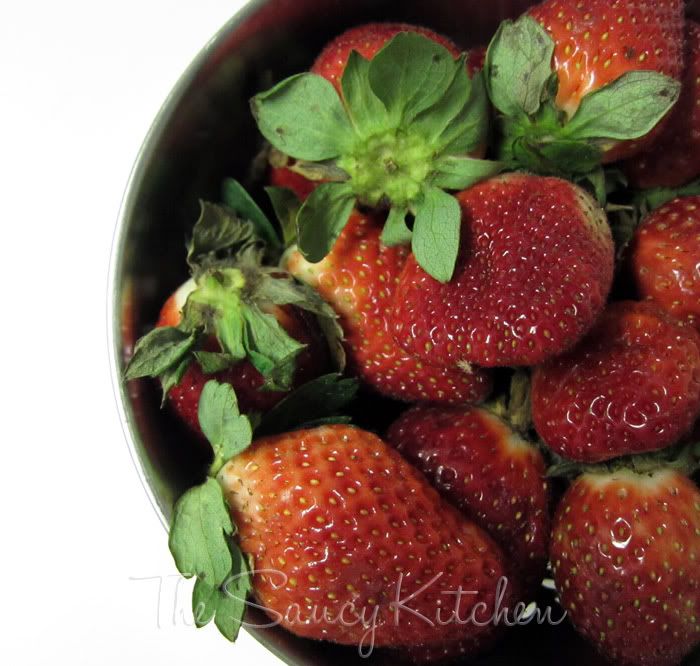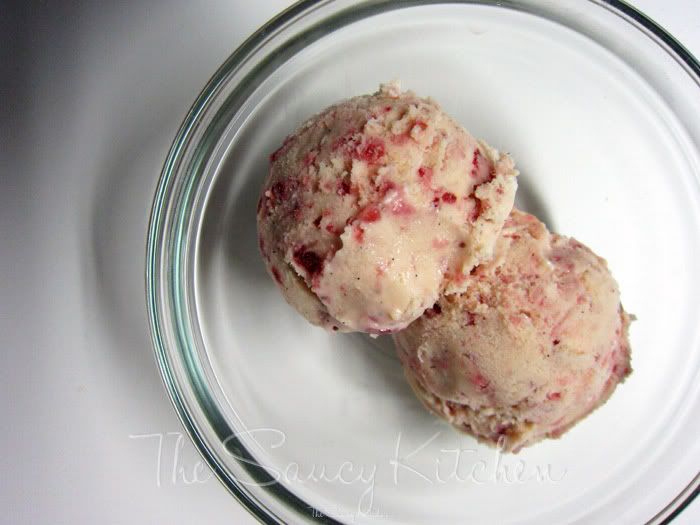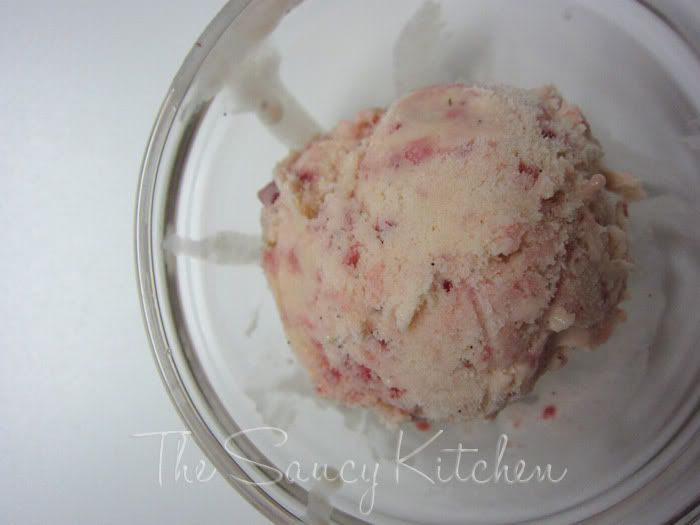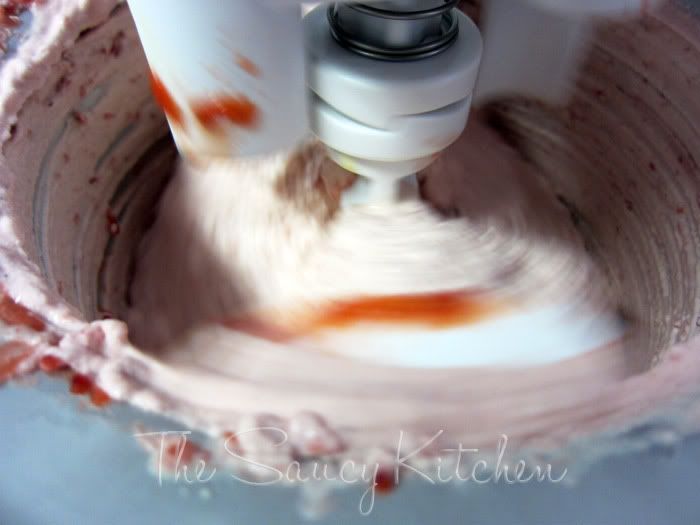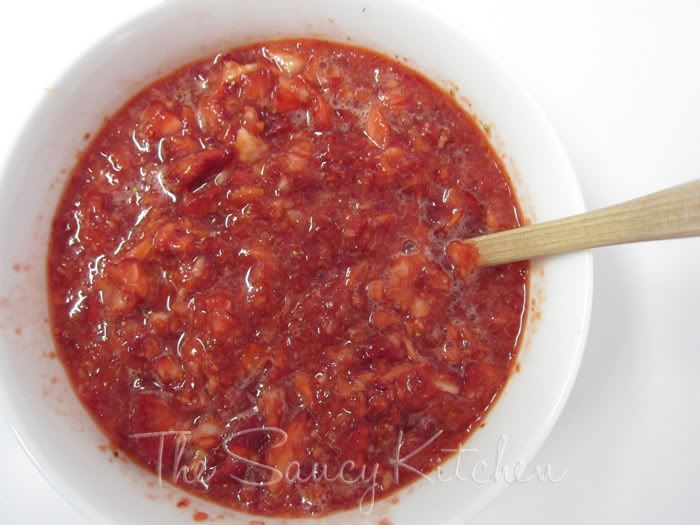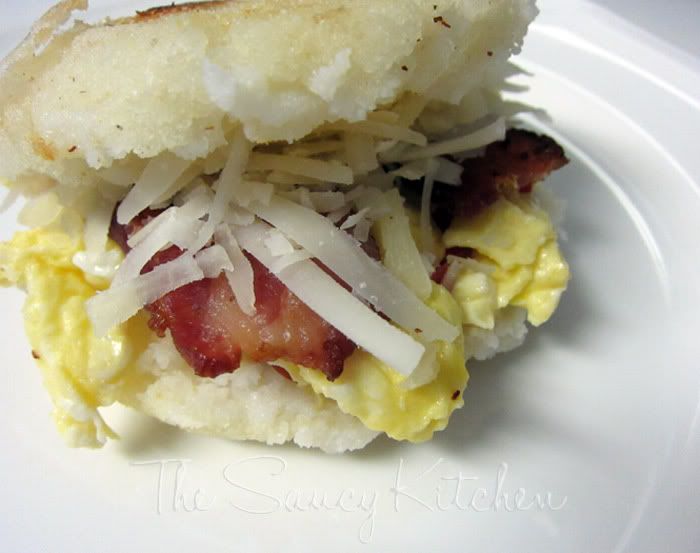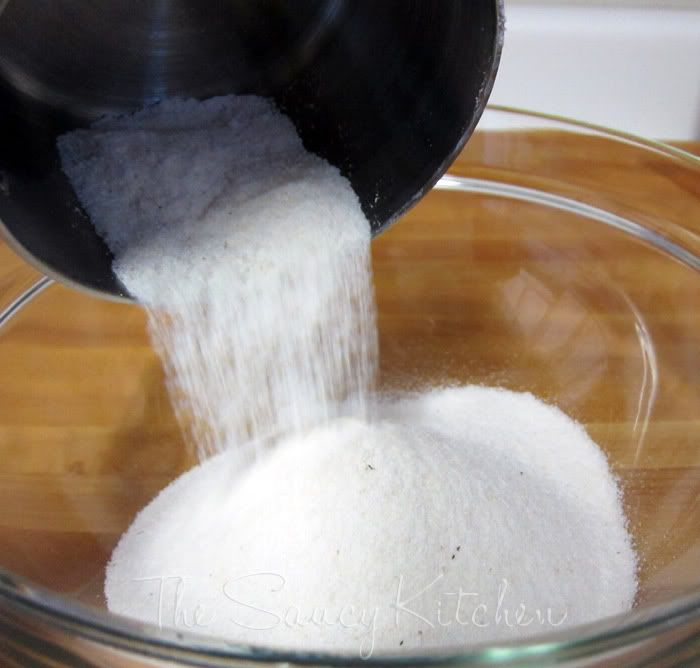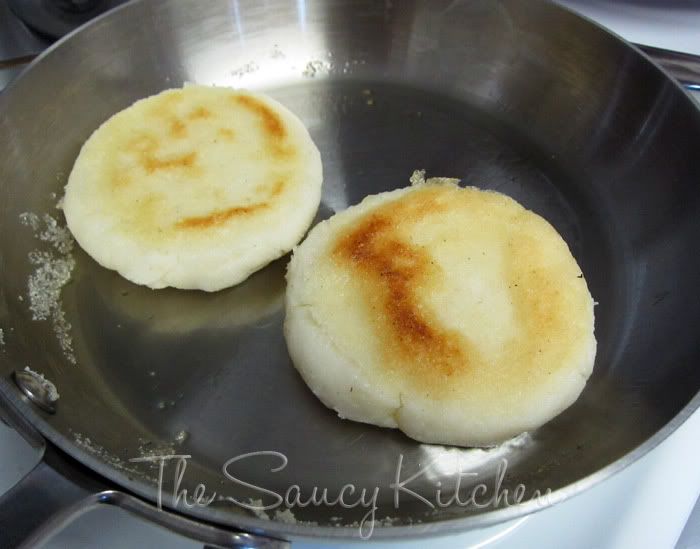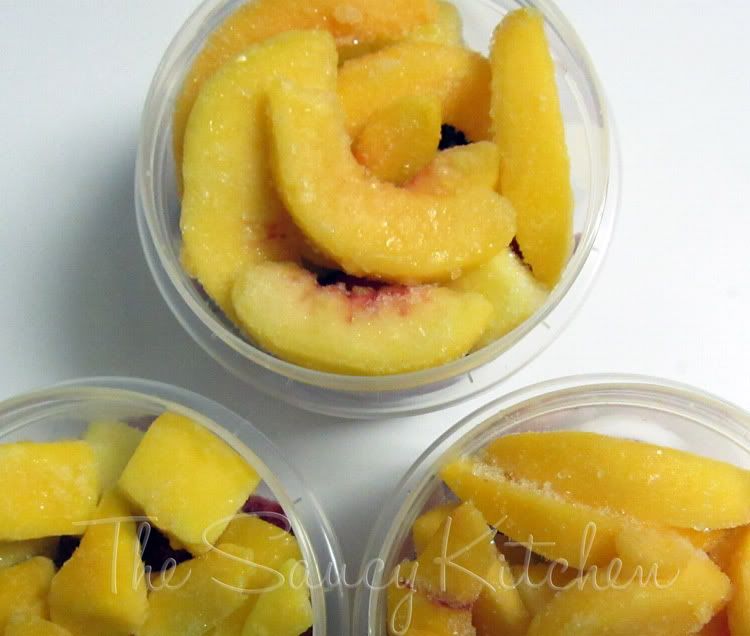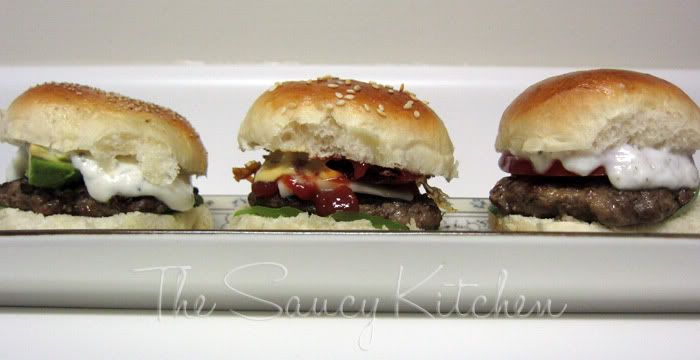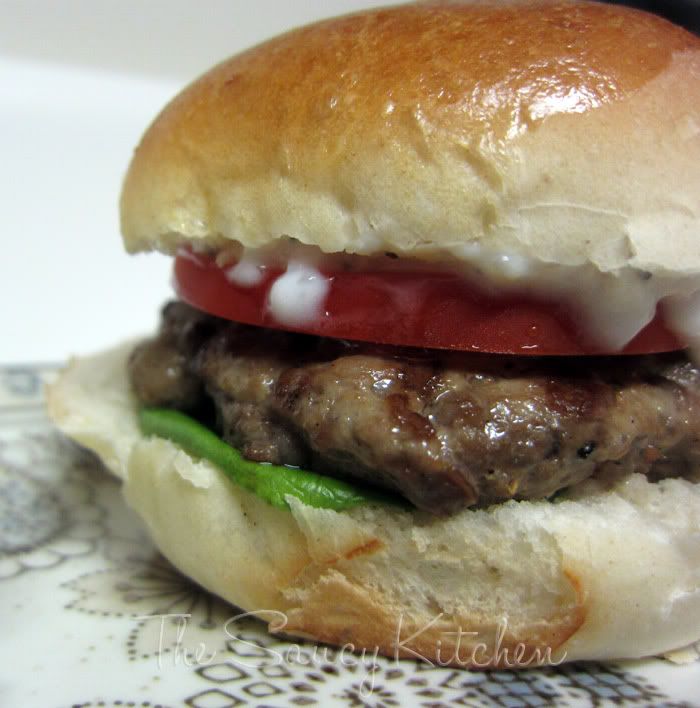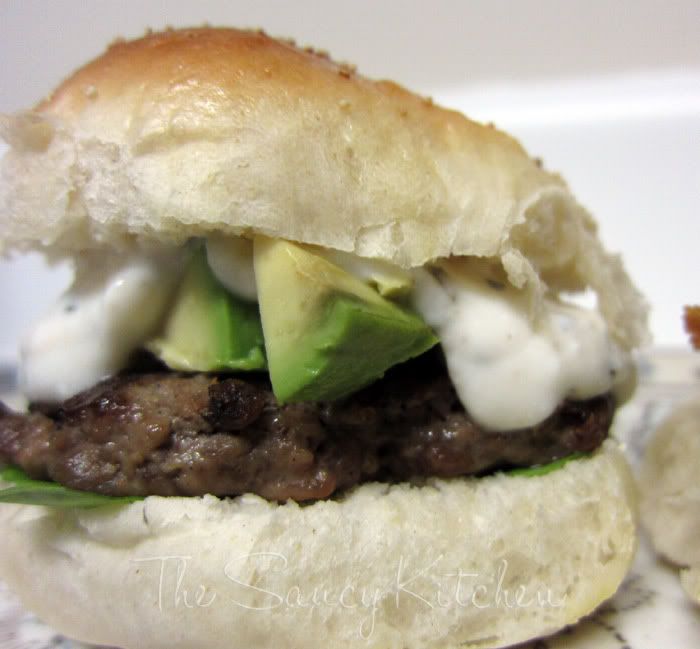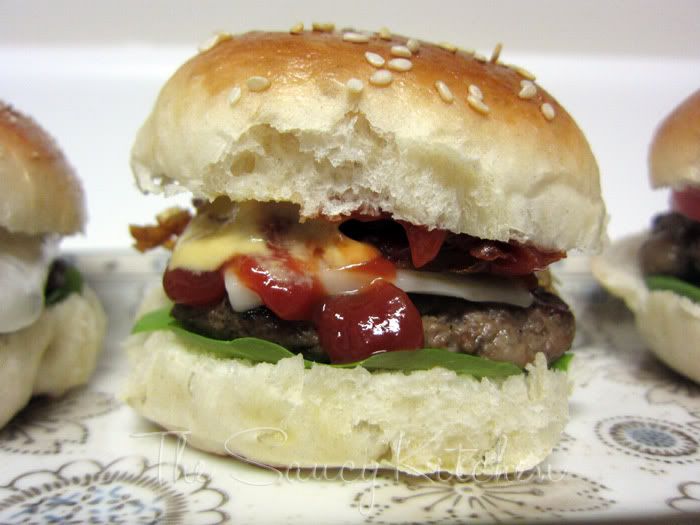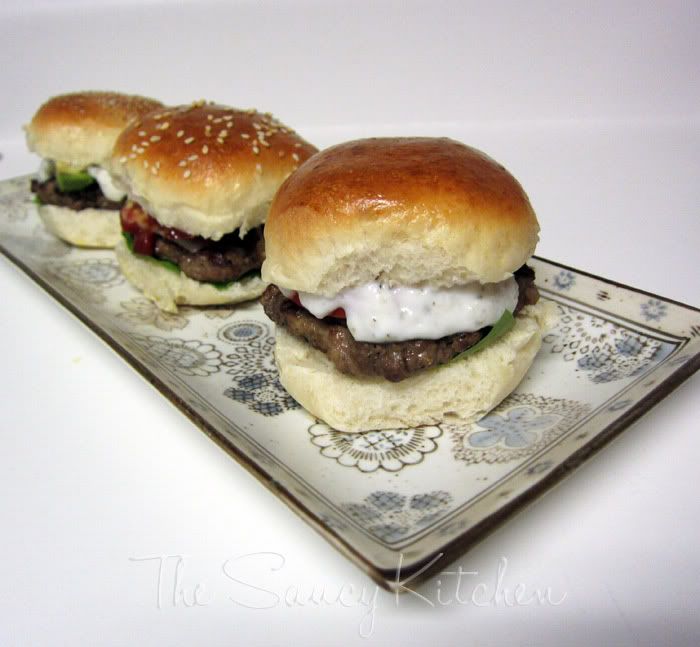This week, I asked some of my favorite food bloggers to tell me about their food philosophy. I love reading about these ladies adventures in the kitchen and often wonder about how they view food. What inspires them in the kitchen? Some people cook out of necessity, some people cook for fun on the weekends, others cook extra nutritious meals to stay healthy so they can run marathons (but that last one wouldn't be me). Some people cook for a family, some cook for only one or two. Some are vegetarians, some are meat and potatoes people. So you can see why even a simple recipe can have so many variations. When I read a recipe, and I start making changes to suit my tastes, I'm infusing it with my food philosophy.
My food philosophy began developing with some of the ideas I was raised with and has grown since then. Early on, my parents limited the amount of sugary junk foods I could have, but had a big bowl of fruit or some other healthy snack that I could eat as I wanted. I learned early on to read nutrition labels - any cereal that had more than 11g of sugar per serving was a no-go, but I could select whatever I wanted as long as it met that requirement. I also went grocery shopping with my mom and would select a "fruit of the week." I could pick anything I wanted, so we tried some things that were pretty tasty and other things that are best left to be ornamental (star fruit).
I think these things early on made me more aware of my food choices and have more responsibility in regard to my eating habits. I went through high school not really interested in cooking and starting a few kitchen fires, melting a few spoons and burning a few pots. Once I got to college, however, I began to develop an interest in cooking more (I think the bad cafeteria food was pretty motivating).
Out on my own after graduation, I certainly enjoyed cooking, but I preferred to cook with people. So, it was absolutely perfect when Nick and I finally moved to the same zip code. I actually feel more adventurous and excited in the kitchen now that I cook for two because I love the reward - the "mmm" or "hun, this is really good." (The other day the ice cream hater himself told me, after polishing off a container, that I made the best ice cream he's ever tasted - *pats myself on the back*). That's positive reinforcement :).
To kick off the week, here's my food philosophy:
Everything in Moderation
I strongly believe in everything in moderation. Since I have to avoid most cow's milk products, I find it too difficult to begin to eliminate other foods. Aside from dairy, I would just rather keep myself open to trying new things. If I feel like experimenting with a fabulously rich dessert, I do. But I also keep my portion sizes in control (and usually give away quite a bit so I don't have too much temptation, will power can only get you so far). Richer foods usually satisfy your appetite with smaller amounts anyway.
Balance
This sort of goes hand in hand with moderation. While I want to eat everything in moderation, I also want to eat a balanced diet. I strive to get a balanced diet - a little protein, a lot of fruits and veggies, and some carbs for quick energy.
Local, Wholesome, Sustainable Ingredients
When I can, I prefer to buy local ingredients (even over organic, but if I can find local, organic ingredients, woo hoo!). I also prefer to use whole ingredients when possible and make things in my own kitchen as opposed to buying prepared store bought items. I don't buy substitutes for things like butter or sugar because I trust nature and God over a guy in a lab. One of my only never buy ingredients is farmed salmon, but that is a whole 'nother post.
Homemade is best.
Convenience foods are convenient, but I find that they don't taste nearly as good as homemade. Aside from taste, I like knowing what goes into my food without needing a dictionary. I also find that making things at home limits the amount of "junk" food I eat. Yes, organic potato chips are still junk, even if they are sold at the health food store. Homemade ice cream is junk too. But if I make it from scratch, I tend to make it less frequently than if I let myself indulge in putting it in our shopping cart each week. I also try and savor it, since I know how much work went into it.
Keep it Fun.
This is probably the most important one of all. For me, cooking and eating wouldn't be as exciting for me if I had points or calories to worry about. I like to have fun with food and experiment. Some of these experiments don't go so well. If they aren't as tasty as I would like, well, it's just food.
Stay tuned this week to hear from some other amazing ladies and get introduced to their inspiring blogs!
Just another perfect Sunday...
Today, Nick and I had a leisurely breakfast at home of apple and cinnamon oatmeal. Then, we ventured out.
We also took a fabulous walk on the beach. The weather was perfect - not too warm, sunny, with the ocean breeze keeping things cool.
It was so much fun - we rescued a starfish, saw several washed up jellies (just why do they commit suicide when there's a full moon?), a crab and a few pups. I played in what Nick considers fish farts - aka the bubbly stuff at the surf - while he told me that I was crazy.
After our walk and a quick stop at the grocery, we came home and worked on a freezer organization project. I'll give you all the details next week, but stay tuned this week for some fabulous posts from some of you.
We also took a fabulous walk on the beach. The weather was perfect - not too warm, sunny, with the ocean breeze keeping things cool.
After our walk and a quick stop at the grocery, we came home and worked on a freezer organization project. I'll give you all the details next week, but stay tuned this week for some fabulous posts from some of you.
Heavenly Strawberry Ice Cream
This past weekend we stopped to do some shopping at the local farmer's market and guess what they had?!
Yep, here in Florida it's Strawberry Season! Sorry, Northerners, but early crops one of the few luxury's we have here before it gets sooo hot. Don't worry, when all you guys are going on and on about your fab gardens, I'm reminded that things don't grow so well in sand and that even palm trees look dead in 95F, full sun with 1000% humidity. Which of course, meant that I had to get a half flat while they lasted.
Because, of course, there are so many things you can do with strawberries - like Strawberry Ice Cream!
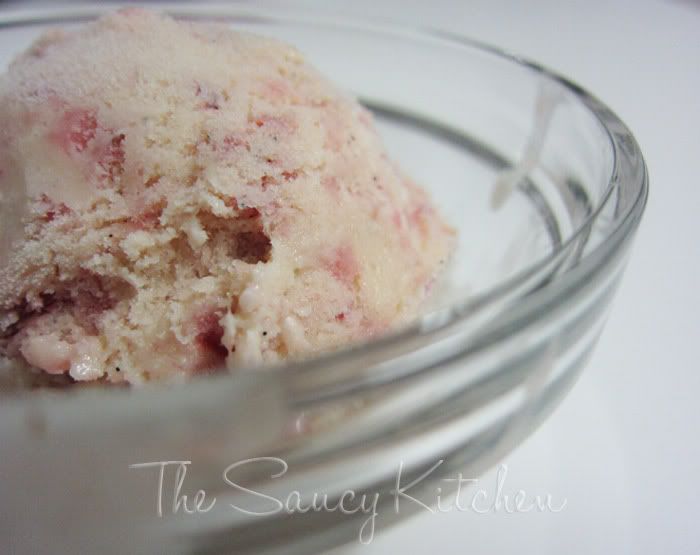
I never actually was that fond of this flavor as a kid. God forbid someone got Neapolitan - I would have to meticulously scrape the sides so I could get all the chocolate, or eat the vanilla with a drizzle of chocolate sauce. But that pink stuff in the middle. No way.
As luck would have it, my taste buds did a turn around and gosh darn it, strawberry is a pretty good flavor. Probably one of my favorites now, so I was very excited to give this a shot.
I used the basic Ice Cream recipe that I used back when I made the vanilla ice cream, but with a few tweaks.
For how-to photos and more instructions, go to my original Almond Milk Ice Cream post.
Strawberries!!!!
Yep, here in Florida it's Strawberry Season! Sorry, Northerners, but early crops one of the few luxury's we have here before it gets sooo hot. Don't worry, when all you guys are going on and on about your fab gardens, I'm reminded that things don't grow so well in sand and that even palm trees look dead in 95F, full sun with 1000% humidity. Which of course, meant that I had to get a half flat while they lasted.
Because, of course, there are so many things you can do with strawberries - like Strawberry Ice Cream!

I never actually was that fond of this flavor as a kid. God forbid someone got Neapolitan - I would have to meticulously scrape the sides so I could get all the chocolate, or eat the vanilla with a drizzle of chocolate sauce. But that pink stuff in the middle. No way.
As luck would have it, my taste buds did a turn around and gosh darn it, strawberry is a pretty good flavor. Probably one of my favorites now, so I was very excited to give this a shot.
I used the basic Ice Cream recipe that I used back when I made the vanilla ice cream, but with a few tweaks.
Strawberry Ice Cream (with Almond Milk)
Ingredients
2 1/2 c almond milk (I prefer the Original to the Vanilla for this recipe since it has less sugar)
1 1/2 c heavy cream
8 large egg yolks
9 ounces sugar
1 vanilla bean, split lengthwise
1 recipe strawberry puree*
Freeze the ice cream mixing bowl (at least 24 hours prior).
Bring the almond milk, cream and vanilla bean to just a simmer in a saucepan over medium heat. Remove from heat as soon as it begins to simmer.
In a mixing bowl (or mixer), whisk the egg yolks until they lighten in color. Gradually add the sugar and continue to whisk until it is combined. The consistency should be thick enough so that the mixture forms a ribbon when you lift the whisk out of the bowl.
Once the eggs and sugar are combined, add in the cream/milk mixture slowly, tempering the eggs so as not to cook them. Continue to add the milk mixture to the eggs, stirring to combine as you go. Once all the milk has been added return the entire mixture to the saucepan and reheat over medium low heat until 170-175 F. This is a necessary step to ensure that the eggs are cooked (and salmonella is killed) before being made into ice cream. Continue to cook until the mixture coats the back of a spoon.
Cool the mixture until it is room temperature and then let cool overnight, covered, in the refrigerator.
Remove the vanilla bean from the custard mixture.
Pour the mixture into the the ice cream mixing bowl and turn on the mixer (or ice cream machine). Churn for 15 to 20 minutes.
At the 15 to 20 minute mark, when the ice cream has frozen and begins to look like, well, ice cream (soft serve, really), add in the strawberry puree. This should mix throughout and continue to churn, allowing the strawberry mix to be incorporated and the ice cream to become about double it's original size.
*Strawberry Puree
Ingredients:
2 pints strawberries
6 tbsp sugar
juice of 1 lemon.
Place the ingredients in a food processor and pulse. I left some chunks in mine so that I would have some in the ice cream. For a smoother ice cream, puree completely. Adjust the sugar and acid to taste, keeping in mind that the ice cream base is rather sweet.
For how-to photos and more instructions, go to my original Almond Milk Ice Cream post.
**Stay tuned next week - I have a treat in store for you!**
Arepas!
Arepas!
It even is fun to say! Anyways, I was introduced to this great breakfast idea by Nick's old roommate. He and his family are originally from Venezuela and this was a common breakfast for them. I think of it as a South American English muffin sandwich. They were cool enough to have an arepa maker (like a waffle maker, but for arepas). We used our hands.
The hardest part is actually finding the flour. It's a white corn meal. Here's the stuff we found in our grocery store to give you an idea of what to look for if you want to try these.
They are so yummy and can be modified to include whatever fillings you have on hand, bacon and eggs, ham and cheese, avocado, tomato, etc.
It even is fun to say! Anyways, I was introduced to this great breakfast idea by Nick's old roommate. He and his family are originally from Venezuela and this was a common breakfast for them. I think of it as a South American English muffin sandwich. They were cool enough to have an arepa maker (like a waffle maker, but for arepas). We used our hands.
The hardest part is actually finding the flour. It's a white corn meal. Here's the stuff we found in our grocery store to give you an idea of what to look for if you want to try these.
They are so yummy and can be modified to include whatever fillings you have on hand, bacon and eggs, ham and cheese, avocado, tomato, etc.
Arepas
Ingredients:
2 c. Masarepa
1 tsp. salt
3 c. warm water
olive oil
fillings of your choice
Preheat an oven to 350 F.
In a mixing bowl, combine the flour, water and salt together with your hands until it is combined. Let it stand for 5 minutes.
Shape the dough into patties about 4 inches wide and 1/2 inch thick.
In a lightly oiled skillet over medium heat, place the formed patties onto the pan. Don't try and move them once they are on the skillet. Allow them to brown on one side and then, when they are brown and no longer sticking to the bottom of the pan, flip them to brown the other side.
Place the arepas on a baking sheet and into the oven for about 20 minutes (or until they sound hollow).
Slice the arepas about halfway through and take out some of the dough if you want (it gives more space for filling). Add in your fillings, really pushing them in so it fills the whole inside of the arepas. Enjoy!
Kitchen Lifesaver: Easy Morning Smoothies
Nick loves smoothies in the morning. And I love getting some fruits into the meat eater. To make mornings go smoother (haha, get it?), I have a system to get this breakfast beverage made in a jiffy.
First, I start with store bought frozen fruits. Whatever you like or is on sale at that particular time. Pineapples, mangoes, peaches, strawberries, blueberries, raspberries and cherries - anything goes. Instead of storing each bag in the freezer separately (taking up a lot of awkward freezer real estate), I make easy two cup mixes on the weekend. It's the perfect serving size for two smoothies and allows you to mix and match the fruits so that your smoothie can be a different flavor each day of the week. It also allows for faster assembly in the am. I keep our fruit cups nested on the door so it's an easy grab when I need one.
I start by throwing two bananas (peeled) into a blender. I then throw the frozen fruit from the serving cup on the top of the banana. I top this with Acai juice until it is about half way up the side of the blender, or just about covering the bananas. Put the lid on and blend on low for about 30 seconds and then bumping up to high until everything is smooth.
Pour into glasses or travel cups (we picked these up at BBB) and you're all set for a quick and easy breakfast.
First, I start with store bought frozen fruits. Whatever you like or is on sale at that particular time. Pineapples, mangoes, peaches, strawberries, blueberries, raspberries and cherries - anything goes. Instead of storing each bag in the freezer separately (taking up a lot of awkward freezer real estate), I make easy two cup mixes on the weekend. It's the perfect serving size for two smoothies and allows you to mix and match the fruits so that your smoothie can be a different flavor each day of the week. It also allows for faster assembly in the am. I keep our fruit cups nested on the door so it's an easy grab when I need one.
I start by throwing two bananas (peeled) into a blender. I then throw the frozen fruit from the serving cup on the top of the banana. I top this with Acai juice until it is about half way up the side of the blender, or just about covering the bananas. Put the lid on and blend on low for about 30 seconds and then bumping up to high until everything is smooth.
Pour into glasses or travel cups (we picked these up at BBB) and you're all set for a quick and easy breakfast.
Lamb Slider Trio
We got leg of lamb for $399/lb. $3.99 A POUND! We had a small roast and then ground the rest, thinking that we could come up with many more recipes for ground lamb - one being lamb burgers. But we never had a lamb burger and didn't know what to pair it with.
So we did what every indecisive couple with a serious cooking hobby would do and experimented with the top three contenders - Greek, Middle Eastern, and American.
The Greek burger included sliced tomato, a slice of romaine and some tzatski sauce on a plain bun.
The Middle Eastern burger included a slice of arugula, a feta/mint/yogurt sauce, and avocado on a poppy seed bun.
The American burger included ketchup, mustard, goat's cheddar cheese, crisped prosciutto, and a slice of arugula on, what else, a sesame seed bun.
I tried to get Nick to rate them, but he couldn't. He said they were all good. I did, but honestly, it was so close.
My favorites:
1. Middle Eastern
2. American
3. Greek
So we did what every indecisive couple with a serious cooking hobby would do and experimented with the top three contenders - Greek, Middle Eastern, and American.
The Greek burger included sliced tomato, a slice of romaine and some tzatski sauce on a plain bun.
The Middle Eastern burger included a slice of arugula, a feta/mint/yogurt sauce, and avocado on a poppy seed bun.
The American burger included ketchup, mustard, goat's cheddar cheese, crisped prosciutto, and a slice of arugula on, what else, a sesame seed bun.
I tried to get Nick to rate them, but he couldn't. He said they were all good. I did, but honestly, it was so close.
My favorites:
1. Middle Eastern
2. American
3. Greek
All to watch Worst Cooks in America. How was your weekend?
Stuffed Artichokes
I made this up for dinner when Nick was feeling under the weather. I needed something quick and easy and full of pantry staples because a trip to the store was not happening. It was a great light meal in and of itself, or could be served as a side or appetizer.
**I also save the stems, cutting off the very end that's usually brown and slicing off the green woody parts vertically until I reach the tender white inside of the stalk. It is only really worth it if the stems are thick.
Stuffed Artichoke* To prep the artichokes, cut the stem around the base of the plant. Also cut off the about 3/4" below the top point. I also like to trim (with kitchen shears) the pointy end of each leaf.
Ingredients:
2 artichokes
2 bay leaves
salt
1/3 c. yellow onion, diced
2 tbsp butter
2 garlic cloves, minced
pepper
pinch oregano
2/3 c. diced tomato, canned
1 tbsp butter
1 tbsp olive oil
1/2 c Pecorino Romano
1 1/2 c. bread crumbs
2 tbsp chopped fresh parsley
Preheat your oven to 400 F. Bring water to a boil in a large pot. Add two bay leaves and some salt to season the water. Add in prepped artichokes* and prepped stems** (optional). Continue to boil lightly with the lid on until you can stick a fork through the base (about 25 minutes).
While the chokes are boiling, prepare the stuffing. Start by heating the butter in a saute pan over medium heat. Add the onions and cook until they are just soft and transparent, about 5 minutes. Add the garlic and saute for about 1 minute. At this point, check to see if the stems are cooked through. If they are, remove them from the water and dice (be careful they are hot - I held mine with tongs while I sliced), then add to the onion mixture. (If they need a few minutes, add them in after the tomato). Add the tomato and stir, continue to cook until the mixture reduces. Add pepper and dried oregano to taste. Once reduced to the desired consistency, reduce the heat to low.
In another pan, melt the butter and olive oil together and heat over medium low heat. Toss in the bread crumbs and toast.
Once toasted, remove from the heat and toss in the cheese and parsley. Add the bread crumb mixture to the tomato-onion mixture and stir to combine the two.
Once the artichokes are done, remove them from the water and sit, facing down on a towel or in a colander to drain and cool. Once cool enough to touch, open up the leaves just enough to get to the center leaves. Pull out those little leaves until you can see the bottom fuzzy parts. Grab a spoon and scrape (gently!) the fuzzy part out of the center, leaving the solid, fleshy part (aka, the best part).
Once the center has been cleaned of all the fuzzies, add in the stuffing. I first add to the center portion and then fill in between each of the leaf layers. Once both have been stuffed, place the artichokes into the oven for another 10-15 minutes. This will re-heat the chokes and crisp up the outer edges of the stuffing.
Remove from the oven and serve.
**I also save the stems, cutting off the very end that's usually brown and slicing off the green woody parts vertically until I reach the tender white inside of the stalk. It is only really worth it if the stems are thick.
New! Menu Planning Resources
Since I believe in menu planning, I've decided to offer some printable menu planners for your personal use. You can find them up on the new Resources tab. Some are self explanatory and supplemental to menu planning - a grocery list (to tape on the fridge, so you can just jot down things when you run out - saving the forgetful among us) and a recipe list (to write down new ideas or recipes you want to try).
There are also weekly and monthly menu planners you can use however you'd like. I've also placed our menu plan (with subtitles) in there as well. I started planning monthly recently, as opposed to weekly, because Nick was always requesting things during the week and we would end up with a giant list of requests. If he's throwing out ideas, I might as well capitalize. Also, it allows us to have a bit more forethought into using our freezer stash, ultimately cutting down our grocery bill.
Here's how it works:
I have each day in one box. I mostly plan lunch and dinners so it's not too complicated - especially when lunch is usually last night's dinner. Under each day I've also included subtitles. These indicate different meal categories which helps to balance out our menu since otherwise Nick would put steak on there every day.
Sunday is the day we can try new recipes since we have the time to do so. Monday through Friday offer quicker cooking ideas like grilling, pastas, prepared (but homemade) freezer meals like pyrohi and ravioli, or a baked pasta. Salad night can include some meat - steak, chicken, shrimp - if it kills you to go meatless. Pantry meals include spaghetti an meatballs, pasta rustica, etc. - anything that can be made from items commonly found in the pantry. These are usually also quick and easy. Craving night is still planned. We write down what we are in the mood for and it gets put on the next available craving night unless it can go in one of the other categories.
These were categories that worked for us. Perhaps you have a weekly out to eat night on Thursdays for pizza - Retaurant night becomes Thursday. If you want to have a Meatless Monday, go for it. Attached to your slow cooker? Take a mid-week cooking break with Slow Cooker Wednesdays. You get the idea. Just keep the categories flexible enough that you aren't eating the same thing every week. Pasta night could mean spaghetti with tomato sauce, it could mean orzo with peas, linguine in clam sauce, or mushroom lasagna. If menu planning becomes monotonous and boring, it becomes less appealing to do.
Don't get too worked up about the days, either. They are meant to act as a guide so that your menu is more or less balanced and to prompt an idea if you are hitting a menu planning rut. But if you think of a recipe you'd like to make and it doesn't fit into an open category, don't not make the recipe! That's just silly. Throw it in where you can. They aren't there to be restrictive.
Above is our menu plan starting on February 13th. I did add some breakfasts on there (in green) since I'm currently hanging out at home, so I might as well eat well. The orange-y color represents lunches. The black text indicates dinners. You can see a few lunches labeled "leftovers" and some dinners labeled as "open." This is so that any accumulated leftovers get eaten up. Sometimes we end up with more left over than we bargained for and so scheduling a few days a month (or once a week) to eat them limits the amount that gets shoved to the back of the fridge, forgotten, and subsequently thrown away. "Open" days are also a good time to make dinners that you skipped if you ended up getting invited out to dinner another day and didn't make one of the scheduled meals.
You can plan an entire month out in one day, or by attaching a blank sheet to the fridge (or where ever is convenient for you), you can begin adding recipes to the next month as your family requests them. If I hear "Hun, I really think lamb sliders would be awesome," they get added onto the next month - perhaps on grill night or on craving night. This way, you don't have to sit down and plan an entire month in one sitting, it evolves over the previous month, leaving you a few little holes to fill in without much time or effort.
If you menu plan, what are some tips that you would suggest to those just starting out?
Entries for the giveaway close at 12 noon today! So hurry up and enter here.
 |
| Click on the image to be redirected to the Resources tab for download instructions. |
 |
| Yes, we are ready for the apocolypse. |
I have each day in one box. I mostly plan lunch and dinners so it's not too complicated - especially when lunch is usually last night's dinner. Under each day I've also included subtitles. These indicate different meal categories which helps to balance out our menu since otherwise Nick would put steak on there every day.
Sunday is the day we can try new recipes since we have the time to do so. Monday through Friday offer quicker cooking ideas like grilling, pastas, prepared (but homemade) freezer meals like pyrohi and ravioli, or a baked pasta. Salad night can include some meat - steak, chicken, shrimp - if it kills you to go meatless. Pantry meals include spaghetti an meatballs, pasta rustica, etc. - anything that can be made from items commonly found in the pantry. These are usually also quick and easy. Craving night is still planned. We write down what we are in the mood for and it gets put on the next available craving night unless it can go in one of the other categories.
These were categories that worked for us. Perhaps you have a weekly out to eat night on Thursdays for pizza - Retaurant night becomes Thursday. If you want to have a Meatless Monday, go for it. Attached to your slow cooker? Take a mid-week cooking break with Slow Cooker Wednesdays. You get the idea. Just keep the categories flexible enough that you aren't eating the same thing every week. Pasta night could mean spaghetti with tomato sauce, it could mean orzo with peas, linguine in clam sauce, or mushroom lasagna. If menu planning becomes monotonous and boring, it becomes less appealing to do.
Don't get too worked up about the days, either. They are meant to act as a guide so that your menu is more or less balanced and to prompt an idea if you are hitting a menu planning rut. But if you think of a recipe you'd like to make and it doesn't fit into an open category, don't not make the recipe! That's just silly. Throw it in where you can. They aren't there to be restrictive.
 |
| Click to enlarge |
Above is our menu plan starting on February 13th. I did add some breakfasts on there (in green) since I'm currently hanging out at home, so I might as well eat well. The orange-y color represents lunches. The black text indicates dinners. You can see a few lunches labeled "leftovers" and some dinners labeled as "open." This is so that any accumulated leftovers get eaten up. Sometimes we end up with more left over than we bargained for and so scheduling a few days a month (or once a week) to eat them limits the amount that gets shoved to the back of the fridge, forgotten, and subsequently thrown away. "Open" days are also a good time to make dinners that you skipped if you ended up getting invited out to dinner another day and didn't make one of the scheduled meals.
You can plan an entire month out in one day, or by attaching a blank sheet to the fridge (or where ever is convenient for you), you can begin adding recipes to the next month as your family requests them. If I hear "Hun, I really think lamb sliders would be awesome," they get added onto the next month - perhaps on grill night or on craving night. This way, you don't have to sit down and plan an entire month in one sitting, it evolves over the previous month, leaving you a few little holes to fill in without much time or effort.
If you menu plan, what are some tips that you would suggest to those just starting out?
Entries for the giveaway close at 12 noon today! So hurry up and enter here.
Happy Valentine's Day!
Hope you all are having a great day celebrating with your Valentine. Mine is in the kitchen making pesto...mmm...
Last night, for an early V-day dinner, we made a roasted leg of lamb ($3.99/ lb!) with a red wine sauce which we served with some roasted cauliflower covered in a Drunken Goat cheese sauce and a loaf of ciabatta bread (no, we didn't eat it all last night, silly).
This morning we had a yummy breakfast of crepes filled with fresh strawberries in maple syrup and topped with homemade sweetened whipped cream. And, of course, a cup of coffee. Perfect start to the day.
Coconut Cake with Cream Cheese Icing
Me and coconut have a funny relationship. We're just getting to know each other. See, I always, always thought of coconut (especially the shredded stuff) as being dry, gross and texturally unappealing. The thought of it gave me shivers. I should have known better - I think the only time I had shredded coconut was on a grocery store bakery cookie. You know the freebie kind they give kids so that their parents have one half-minute of peace before the sugar rush kicks in? That coconut. No wonder we had issues.
But this coconut I can get behind. Unfortunately, it also is quite a lengthy process, but so worth it. If you aren't a purist, you could use store bought extract, coconut milk, coconut cream and shredded coconut which would make this a much faster cake, but I wanted to try it with fresh ingredients first. It turned out great - soft, moist, sweet but not overpowering. I think the fresh coconut adds a lightness that you wouldn't get with the store bought shredded stuff. If I do ever make this with store bought ingredients, I will definately share with you it's shortcomings if there are any.
*For instructions on how to make the coconut cream, coconut milk, coconut water, coconut extract and shredded coconut, refer to my post on coconut cake prep.
But this coconut I can get behind. Unfortunately, it also is quite a lengthy process, but so worth it. If you aren't a purist, you could use store bought extract, coconut milk, coconut cream and shredded coconut which would make this a much faster cake, but I wanted to try it with fresh ingredients first. It turned out great - soft, moist, sweet but not overpowering. I think the fresh coconut adds a lightness that you wouldn't get with the store bought shredded stuff. If I do ever make this with store bought ingredients, I will definately share with you it's shortcomings if there are any.
Coconut Cake
from this recipe from Alton Brown
icing recipe from the Barefoot Contessa
Ingredients:
Vegetable Oil
14 1/4 ounces cake or pastry flour, plus extra for pans, about 3 c.
1 1/2 tsp. baking powder
1 tsp. salt
1/2 c. fresh coconut milk*
1/2 c. fresh coconut cream*
8 oz. unsalted butter, at room temperature
16 oz. sugar, about 2 1/4 c.
1 tsp. coconut extract*
4 egg whites
1/3 c. coconut water*
1 lb. cream cheese, at room temperature
2 sticks unsalted butter, at room temperature
3/4 tsp. vanilla extract
1/4 tsp. almond extract
1 lb. powdered sugar, sifted
6 oz. shredded coconut*
Preheat the oven to 350 degrees F.
Lightly oil your cake pans. I used a 8" pans. Cut a piece of parchment paper to fit the bottom of the pan. Lay that in over the oil and then oil the parchment paper. Flour the pan lightly with cake flour and set aside.
Combine the flour, baking powder, and salt into a mixing bowl and whisk to combine.
Combine the coconut milk and coconut cream in small bowl and set aside.
Cream the butter using the paddle attachment on your stand mixer on medium speed until it is fluffy. Decrease the speed on the mixer to low and slowly add the sugar over about 1 to 2 minutes. Scrape down the sides and continue mixing the butter sugar combination on medium until it is light and fluffy (about 2-3 minutes). Stir in the extract.
Turn the mixer on low and add the flour and milk mixtures alternately in three batches to the butter and sugar. Begin by adding the flour and end with the milk. Mix until just combined, don't over mix.
In a separate bowl, whisk the egg whites until they form stiff peaks. Fold the egg whites into the batter, just until combined.
Pour the mixture into the prepared cake pans so they are basically equal. You can drop (gently and from just a few inches) the pans onto the counter to remove any air and distribute the batter evenly.
Place into the oven on the middle rack and bake for 30 minutes of until the cake is golden in color and a toothpick inserted into the center of the cake comes out clean. Cool in the pan for 10 minutes and then remove and transfer the cakes to a cooling rack.
When cool, cut each cake into 2 layers, forming a total of 4 layers. With the cakes cut side up, brush coconut water onto the cakes using a pastry brush.
To make the frosting, add the cream cheese, butter, vanilla and almond extract to a mixing bowl. Using the paddle attachment of your mixer, mix on low until the ingredients are combined. Add the powdered sugar (sifted) in small batches so that large clumps don't appear. Don't worry if a few do, though, just use some shredded coconut to cover when assembling.
To assemble the cake, place the first layer on your plate or cake platter. Add frosting to the first layer and, using an offset spatula, spread until it is an even layer and is to the outside edges. Top the icing with shredded coconut. Continue to add the layers until you have assembled all four cake layers. Once all the layers of the cake have been added, frost the ouside of your cake and dress with more shredded coconut. Cool in the fridge prior to serving.
*For instructions on how to make the coconut cream, coconut milk, coconut water, coconut extract and shredded coconut, refer to my post on coconut cake prep.
Subscribe to:
Posts (Atom)







